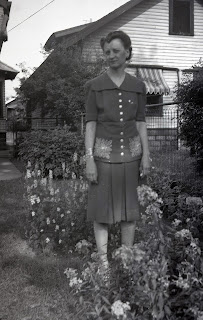Teacher, Margaret Striebeck, lived a full life. Her scrapbooks reveal that the single woman traveled with friends all over the United States. She also entertained friends at her home at 606 North Bosart Avenue in Emerson Heights. In these candid photos, two of her friends posed in the backyard of the Striebeck home. Behind the unidentified women you can see the rear of the dwellings at 602 and 528 North Bosart. The photos were likely shot in the month of May as it appears that both phlox and peonies are blooming or about to bloom. These photos are from the Margaret Striebeck collection.
Friday, June 28, 2013
Wednesday, June 26, 2013
Phoenix Rising Along East Washington Street
For two years, the neighborhood has held its breath. Would the former Irvington Post Office/Hook's Drug Store survive another year? In near ruinous condition due to poor stewardship, the structure had deteriorated rapidly. Thankfully, the Irvington Development Corporation and the Irvington Historical Society partnered to save the structure. They bought the building and found grant money to stabilize it. This week, workers have removed the roof and shored up the walls. They are in the process of rebuilding the second floor and will soon rebuild the roof. I commend the leaders of these two organizations for having the foresight and the will to save a piece of Irvington's heritage. This is certainly a great day for Irvington and the commercial corridor along East Washington Street.
Monday, June 24, 2013
Mr. Striebeck and His Amazing Pet Squirrel
After he retired as a plasterer, Harry Striebeck settled down to a quiet life with his wife Elizabeth and adult daughter, Margaret, at his home at 606 North Bosart Avenue in Emerson Heights. Mr. Striebeck kept a meticulous yard and even trained a squirrel as a beloved pet. In these photos, taken c1945, Mr. Striebeck sits or stands in his backyard with his well-heeled squirrel. In the top two photos, Mr. Striebeck relaxes next to his garage in the backyard. Behind him, vines are beginning to grow up his trellises. In front of him, sits the family lawnmower. In the third photo, the elderly man stands and feeds his squirrel, which is perched on the family lawn chair. Behind Mr. Striebeck, you can see the rear of 606 and 610 North Bosart Avenue. Note the awnings on the windows and the broom hanging from the back porch of his neighbor's home. A metal tub sits atop the cistern and is apparently filled with flowers. This little slice of life was recently developed from some negatives from the collection belonging to Margaret Striebeck. Miss Striebeck passed away in 1976.
 |
| Harry Striebeck and his new friend c1945 in the backyard and next to the garage at 606 N. Bosart Avenue |
 |
| Squirrel on the lap of Harry Striebeck (606 N. Bosart) c1945 |
 |
| Harry Striebeck feeds a pet squirrel. Behind him, you can see both 606 and 610 North Bosart Avenue c1945 |
Thursday, June 20, 2013
The Striebecks of Bosart Avenue
Harry and Elizabeth Boller Striebeck, both the children of German immigrants, dwelled in the Cottage Home (formerly called Noble's Farm or Subdvision) neighborhood just east of downtown Indianapolis. They lived in the Boller home on Pine Street until shortly after the death of her father. By 1916, the couple had saved up enough money to build a small, but beautiful two-bedroom home at 606 North Bosart Avenue (formerly 530 North Bosart) in the new streetcar suburb of Emerson Heights, just west of Irvington. Their only child, Margaret, was 19 years-old at the time and was beginning her training towards becoming a teacher. By 1923, Margaret served as an elementary instructor for the Indianapolis Public Schools. She would live out the remainder of her life in the home on Bosart. Her father, a plasterer, helped to build the French Lick Hotel in southern Indiana. Her mother kept house while both Harry and Margaret were away at work. Miss Striebeck touched hundreds of lives over the years as a teacher. After both of her parents passed away, she continued to dwell in the house until her death in 1976.
With no heirs, her lovely home filled with antiques, became a rental. The old furniture and her mementos were relegated to an unfinished attic where they remained for years. Various leasers over the decades, sold or took some from her collection. In 1993, one of the renters approached me with a box filled with photos and artifacts from Miss Striebeck's life. They were going to throw the items in the trash. I took the collection and have held onto to it for many years. Recently, I had some of her negatives developed and I have tried to track down people in some of the photos and Christmas cards that she saved. Most of us don't get remembered for very long. Within a few generations, we are usually forgotten unless someone comes looking for us. Miss Striebeck, with no children of her own, has likely lived on in the memories of her former students, who are also now reaching their elder years. Many have likely already passed. Miss Striebeck, you are not forgotten. I never knew you, but your letters and notes reveal that you were loved as a teacher and as a friend. I dedicate this post to your memory.
In the top image, Harry and Elizabeth Striebeck along with their daughter, Margaret posed next to the side of their home at 606 North Bosart Avenue. You can also see the bungalow at 602 North Bosart. The photo was likely taken around 1945. In the second photo, shot around the same time, Margaret Striebeck stands in her backyard next to the garage. Behind her you can see the rear of 606 N. Bosart. A cement sistern sits on the ground near the home. It is clearly a cool day with leaves not yet raked at her feet. The final two photos show her classroom in an unidentified IPS school. Be sure to note her beautiful handwriting and the words that students had to use for their assignment. The classroom is very clean. The desks are polished and it might be around Halloween based upon some of the decorations in the room. The photos along the chalk ledge in one of the pictures indicate that the images may have been taken around 1940.
With no heirs, her lovely home filled with antiques, became a rental. The old furniture and her mementos were relegated to an unfinished attic where they remained for years. Various leasers over the decades, sold or took some from her collection. In 1993, one of the renters approached me with a box filled with photos and artifacts from Miss Striebeck's life. They were going to throw the items in the trash. I took the collection and have held onto to it for many years. Recently, I had some of her negatives developed and I have tried to track down people in some of the photos and Christmas cards that she saved. Most of us don't get remembered for very long. Within a few generations, we are usually forgotten unless someone comes looking for us. Miss Striebeck, with no children of her own, has likely lived on in the memories of her former students, who are also now reaching their elder years. Many have likely already passed. Miss Striebeck, you are not forgotten. I never knew you, but your letters and notes reveal that you were loved as a teacher and as a friend. I dedicate this post to your memory.
In the top image, Harry and Elizabeth Striebeck along with their daughter, Margaret posed next to the side of their home at 606 North Bosart Avenue. You can also see the bungalow at 602 North Bosart. The photo was likely taken around 1945. In the second photo, shot around the same time, Margaret Striebeck stands in her backyard next to the garage. Behind her you can see the rear of 606 N. Bosart. A cement sistern sits on the ground near the home. It is clearly a cool day with leaves not yet raked at her feet. The final two photos show her classroom in an unidentified IPS school. Be sure to note her beautiful handwriting and the words that students had to use for their assignment. The classroom is very clean. The desks are polished and it might be around Halloween based upon some of the decorations in the room. The photos along the chalk ledge in one of the pictures indicate that the images may have been taken around 1940.
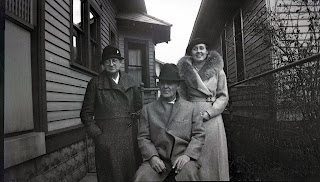 |
| Elizabeth, Harry, and Margaret Striebeck at 606 North Bosart Avenue c1945 |
 |
| Teacher, Margaret Striebeck stands in her backyard at 606 North Bosart Avenue c1945 |
 |
| Miss Striebeck's classroom in an unidentified Indianapolis Public School c1940 |
 |
| Beautiful handwriting on the chalkboard is that of Miss Margaret Striebeck, who taught in this unidentified Indianapolis Public School (c1940) |
Sunday, June 16, 2013
Children Gather Along Ritter Avenue c1908
These beautiful shots of children dressed in their Sunday finest, shows many neighborhood children on the front lawns of 60, 66, 65, and 67 North Ritter Avenue c1908. The only houses visible in the photos are those of 65 and 67 North Ritter. You will note that the city was beginning to brick the street. Two of the girls in the photos are likely Helen and Margaret Hackleman who were born at 28 North Ritter, but grew up next door at 34 North Ritter. Their Aunt Ida and Uncle George Russell dwelled just a few houses north at 60 North Ritter.
Thaddeus and Jennie Major dwelled at 67 North Ritter in 1908. They had two children, Bonnie, who would later become a teacher, and Carl. Mr. Major was both a contractor and accountant at different points in his life. Mrs. Major was an active club woman and frequently hosted the Daughters of the American Revolution in her home. One of the highlights of their time at 67 North Ritter came on August 14, 1913, with the marriage of their daughter Bonnie to Irvington resident, Louis Richardson. The newlyweds moved into the house and would remain for the rest of their lives.
Next door at 65 North Ritter, the elderly David Robertson, lived with several of his adult children. One of his sons, Dr. J. Frank Robertson practiced medicine at 2313 East Michigan Street. Another son, Lou A Robertson, was a well-known attorney. Lou also lived in the house with his wife Mary. The Robertsons may have the record for the family who has dwelled in an Irvington house for the longest period of time. They moved into the beautiful American Four Square in the early 1900s and the last Robertson did not leave until the 1980s.
The historic photos are courtesy of the Irvington Historical Society, Larry Muncie Collection.
 |
| Neighborhood children gathered for a photo on the front yard of either 60 or 66 North Ritter Avenue c1908 |
 |
| Children playing (c1908) at 60 or 66 North Ritter Avenue |
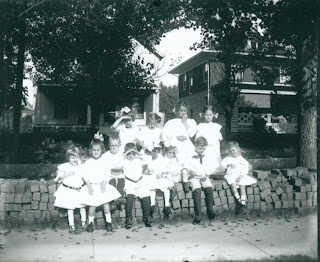 |
| Children sit on bricks in front of 67 and 65 North Ritter Avenue |
Thaddeus and Jennie Major dwelled at 67 North Ritter in 1908. They had two children, Bonnie, who would later become a teacher, and Carl. Mr. Major was both a contractor and accountant at different points in his life. Mrs. Major was an active club woman and frequently hosted the Daughters of the American Revolution in her home. One of the highlights of their time at 67 North Ritter came on August 14, 1913, with the marriage of their daughter Bonnie to Irvington resident, Louis Richardson. The newlyweds moved into the house and would remain for the rest of their lives.
| The Major Home in the winter of 2012. Note that a brick porch has been added most likely in the 1920s. |
Next door at 65 North Ritter, the elderly David Robertson, lived with several of his adult children. One of his sons, Dr. J. Frank Robertson practiced medicine at 2313 East Michigan Street. Another son, Lou A Robertson, was a well-known attorney. Lou also lived in the house with his wife Mary. The Robertsons may have the record for the family who has dwelled in an Irvington house for the longest period of time. They moved into the beautiful American Four Square in the early 1900s and the last Robertson did not leave until the 1980s.
| The Robertson Home in the winter of 2012 |
The historic photos are courtesy of the Irvington Historical Society, Larry Muncie Collection.
Friday, June 14, 2013
Missions Building c1915
The Christian Woman's Board of Missions opened their training school in Irvington in 1910. Hundreds of missionaries over the years received training at the school operated by the Disciples of Christ. Graduates traveled the world and some came back to teach at the institution. Butler University students were allowed to attend classes there and had only a short walk from campus. Chinese, Tibetans, and Indians were just some of the nationalities who came to live in Irvington to work at this international institution. The Disciples of Christ moved their headquarters onto the site and 222 Downey Avenue was on letterheads and envelopes in places like Beijing, Tokyo, and Cairo. The institution eventually added wings so the view shown in today's historic image is no longer possible.
The historic postcard shows women in their long dresses gathered at the entrance of the building. Someone has marked an X on one of the windows perhaps indicating the office for where he or she worked.
By the 1990s, the Disciples of Christ pulled out of Irvington provoking a small crisis as to what to do with the sprawling complex of buildings. One proposal called for knocking down all of the buildings, including the Bona Thompson Library, for condos. Stalwart Irvington neighbors rallied and found a developer to turn the site into senior citizen housing, thus saving the historic buildings for another century.
The historic postcard shows women in their long dresses gathered at the entrance of the building. Someone has marked an X on one of the windows perhaps indicating the office for where he or she worked.
 |
| Christian Woman's Board of Missions c1915 |
By the 1990s, the Disciples of Christ pulled out of Irvington provoking a small crisis as to what to do with the sprawling complex of buildings. One proposal called for knocking down all of the buildings, including the Bona Thompson Library, for condos. Stalwart Irvington neighbors rallied and found a developer to turn the site into senior citizen housing, thus saving the historic buildings for another century.
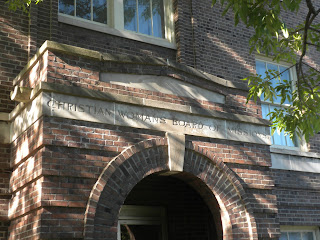 |
| Side entrance to Missions Building in 2013 |
Monday, June 10, 2013
IPS #57 Grade Eight School Photo--1934
Although it would be highly unlikely today, teachers of the graduating class of 1934 from IPS #57 directed the students down Johnson Avenue from East Washington and Ritter to the Irvington Presbyterian Church for a class photo. The church was only six years old in 1934 so perhaps the photographer, W. Frank Jones, thought that the site made for a better setting that the older school. Most of the students are dressed in their finest despite the fact that the Great Depression likely took a toll on many Irvington households. The girls are wearing dresses and at least two of the boys are wearing ties. One young man in the top row has his hand over his heart. Another young man is still donning his beret. Sadly, most of the names are the lost to the ages now so if you recognize anyone in this photo then drop me a line at sleeth28@rock.com. This wonderful image is courtesy of Don Rouse. His mother, Christine Bruckman, is in the front row.
 |
| Members of the grade eight class from IPS #57 pose for their graduation photo in front of the Irvington Presbyterian Church in 1934. |
Friday, June 7, 2013
Ninety Years Earlier...A Visit
We paused before a house that seemed
A swelling of the ground;
The roof was scarcely visible.
The cornice but a mound.
Emily Dickinson
Weaver's Air Service flew over Irvington in the winter of 1923 and snapped at least two aerial photos of the neighborhood. This incredible image displayed today revealed homes along South Audubon Road, University Avenue, Oak Avenue, Dewey Avenue, and Beechwood Avenue. While I did not have time to call upon every house in the picture, I asked Mr. Weaver to drop down so I could pay a visit to a few places. How often does one get transported back in time? I could not pass up this opportunity.
 |
| Aerial Shot of southern Irvington in 1923 (click to make the photo larger) |
I began my tour by trekking down the brick street of Audubon Road just south of the Irving Circle (upper left of the photo) to pay my respects to the Thomas K. Canfield family at 269 South Audubon Road. Mr. Canfield managed his own company and rented this lovely American-Four Square. Adelaide Conte, a well-known music teacher, had just vacated the home. Many children in the neighborhood took vocal and instrumental lessons inside the cobblestoned dwelling. The Canfields had just moved in so I decided not to dwell long, but I couldn't help but notice the solid stone fireplace in the living room and the beautiful oak woodwork.
 |
| 269 South Audubon Road in 1920 |
| 269 South Audubon in 2011 |
Next door, at 275 South Audubon Road, I noted that the Pi Beta Phi sorority girls were very welcoming. Some young women were playing the piano while others were singing. They had only a short walk to classes at Butler University from this wonderful abode. The chapter president, Margaret Kellenbach, who welcomed me, had bobbed hair like most fashionable young women of the Roaring 20s. The place was festooned in the colors of wine and silver blue. Above the fireplace, hung the sorority motto, For Every Girl, A Man or Two. Although it was difficult to leave this lively place, I decided to move on to my next stop.
 |
| Pi Beta Phi House in 1923 at 275 South Audubon Road |
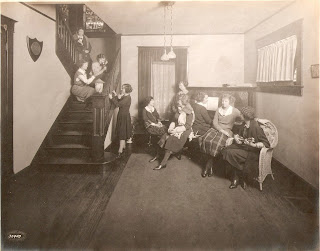 |
| Interior shot of Pi Beta Phi House at 275 South Audubon Road in 1923 |
Two doors down at 307 South Audubon Road, I was greeted by the Nichols. William Nichol, the manager of the White Haine Optical Company, and his family were one of the many to call this high-class rental "home." In fact, the place seemed to be a revolving door as at least nine other families had lived there since 1907. It looked like the Nichols would not be staying long. I saw that Mrs. Nichol was already packing some boxes. Another family, the Griffiths, had leased it for 1924.
 |
| 307 South Audubon Road c1923 |
 |
| 307 South Audubon Road in 2013 |
The tall Queen Anne home at 315 South Audubon Road had intrigued me for years. I was surprised to learn that only three people lived here in 1923. Forty-three-year-old Waller Filson and his thirty-two-year-old wife, Sarah, answered the door. The couple told me that they had met back home in Pennsylvania, and that Waller's brother, Adna, who was 38, also lived here. Both the Filson brothers worked for a local telegraph company. Mr. Filson owned the home and of course, I knew that he and his wife would continue to dwell there for another twenty-five years.
 |
| 315 South Audubon Road in 2013 |
I crossed the intersection of Oak Avenue and looked down the block. I could see that the towering oaks provided a beautiful canopy for the street in 1923 just as they did in 2013. At the southeast corner, I spotted the large Italianate at 325 South Audubon Road. Everyone in the neighborhood still called it the Howe home in 1923, although a new family, the Eberts, had just moved in. The Howes were storied people and one of their descendants, Thomas Carr Howe, had served as the President of Butler University from 1908 to 1920. The Eberts were very different from the Howes. Otto and Lena both spoke German fluently. Mr. Ebert worked as an engineer for the Irvington Ice and Coal Company on South Ritter Avenue. They raised most of their five children on Burgess Avenue, but Otto Jr. spent the majority of his teen years in this fine old home. I bade them goodbye and was stunned when I walked out the door and headed south.
 |
| 325 South Audubon Road in 2013 |
Where were the houses? A huge empty lot sat south of the Howe-Ebert home. The five bungalows that now occupy the site were not present in 1923. In fact, there was a path that locals created to cut over to Beechwood Avenue on the vast green space. Across the street, I saw more empty space. Incredible!
I crossed the intersection and paid my respects to the widow, Laura Weaver, who owned a Dutch-Colonial Revival duplex at 353-55 South Audubon Road. Ms. Weaver had just turned 53 and had been alone for a while as her son had just moved out to start his adult life. To make ends meet, she rented rooms on her side and leased out the other side to the Asbury family. Joseph Asbury worked as a clerk for the rail lines. He was 43 while his wife, Martha was 37. Three young children certainly added a lot of life for the corner. Ms. Weaver would have been surprised had I informed her that by 2013, her home was no longer a double! I decided that to keep that secret to myself.
 |
| 353 South Audubon Road in 2013 (formerly 353-55) |
My final stop for the day would be across the street. The Hartig family dwelled at 358 South Audubon Road on the southwest corner of Audubon and Beechwood. The tall home had been on the corner since the late nineteenth-century. The Hartigs had been in the dwelling for at least ten years and they knew the Howes from the next the block. Joel Hartig had a variety of jobs, but his most recent as a salesman of livestock, provided the most stability. His son, Gravis, worked with him. Martha, his wife, stayed home and helped to raise Marguerite, Alice, and Susanna. I looked out a southern window in the parlor and I could see a beautiful bungalow that had just recently been built on a lot next to the Hartigs. If Mrs. Hartig had opinion on the contrast of homes with hers towering and the new one hugging the ground, she didn't comment. I longed to go upstairs and tour the entire place, but as I was not that familiar with the family, I did not think it pertinent to ask.
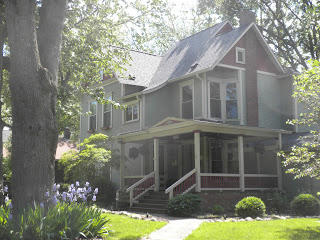 |
| 358 South Audubon Road in 2013 |
With so little time, I had to scurry back to Weaver's airplane. I was disappointed that I could not jog down some of the other streets. Off in the distance, I noted the chimney stack of the Children's Guardian Home. I had been told that over fifty "inmates," as they were called in 1923, had refuge there. I wished I could warn Mr. and Mrs. Oberholzter, who lived across the street from the Guardian Home on University Avenue, about the dangers that awaited their daughter Madge. If only I could tell them that in two years the lovely State House secretary would meet a horrible fate at the hands of the brutal Ku Klux Klan leader D. C. Stephenson. Madge, do not go to his house! Perhaps on another visit? Mr. Weaver had grown impatient with me as it was time to return to the "present." Our plane banked right and I looked down one more time at 1923.....
Thursday, June 6, 2013
Our Gang--South Hawthorne Lane (1929)
The cycle of life is very evident along streets in neighborhoods. For decades, blocks can be noisy and filled with the voices of children. Then, they grow quiet as the avenues are inhabited with the middle aged and the elderly--and then noisy again with the arrival of younger families. I can only imagine how lively South Hawthorne Lane must have been in 1929 when this photo was taken. Several Irvington families including the McKeands (136 South Hawthorne Lane), the Bruckmans (141 South Hawthorne Lane), the Shermans, the Moores, and the Heffernans were represented in this picture. The children were standing in front of the Duff home at 135 South Hawthorne Lane. Three children have been positively identified thus far. Christine Bruckman can be seen standing in the top row, the fourth child from the left. Her brother, George Bruckman, is the second child from the right in the middle row. Joan Bruckman can be seen standing next to the little boy with the dog in the front row. The historic image is courtesy of Don Rouse. His mother, Christine Bruckman, is in the photo. The contemporary photo shows that the area around 135 South Hawthorne Lane is quiet today although the voices of children could be heard further up the block.
 |
| The gang is all here! Children stand in front of 135 South Hawthorne Lane in 1929. |
 |
| 135 South Hawthorne in 2013 |
Tuesday, June 4, 2013
Irvington Methodist Church Then and Now
This beautiful Tudor-Revival structure has graced the "north" circle since 1925. Designed by architect, Herbert Foltz, the church replaced an earlier building on Layman Avenue. (now a parking lot for businesses along East Washington Street) Mr. Foltz decided to position the structure towards Lowell Avenue rather than tear down the double-gabled home that faced East Washington Street. The dwelling had been occupied by both the Forrest and Howe families. Thomas Carr Howe would later become the President of Butler University and for whom Irvingtonians named their local high school in 1938. His home now serve as offices and school space for the church. The intersection of Lowell Avenue and North Audubon Road is one of the loveliest in the city of Indianapolis.
 |
| Irvington Methodist Church c1930 |
 |
| Irvington Methodist Church on June 3, 2013 |
| Forrest-Howe Manse now incorporated into the Irvington Methodist Church |
Subscribe to:
Posts (Atom)
